Black Sea Wines
by
Terry Sullivan
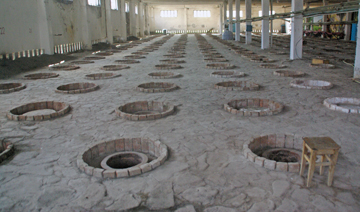 Summary: Some wine cellars are quite small with just a few buried qvevris. Imagine though a warehouse-like marani with hundreds of qvevris under one roof. Black Sea Wines is rebuilding their winery. The site in Kardenakhi, Kakheti has several buildings filled with buried qvevris.
Summary: Some wine cellars are quite small with just a few buried qvevris. Imagine though a warehouse-like marani with hundreds of qvevris under one roof. Black Sea Wines is rebuilding their winery. The site in Kardenakhi, Kakheti has several buildings filled with buried qvevris.
We visited the largest warehouse housing hundreds of qvevris. The building was built in 1912. Another building on the property has some qvevris that are a century old. In the main building, a temporary wall separates the marani into two sections. There are wall-sized pictures of grapes and grapevines that adorn this wall.
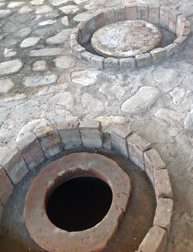 The eye scans the floor of the large facility noting hundreds of brick-outlined circles that mark a qvevri opening. Between the qvevris the floor is made of cement with inset stones. The circumference of bricks extend a few inches above the floor surface. Some of the circles marking qvevris were covered with black sand, evidence that wine was in the qvevris. Other circles were open and you could look into the empty qvevris.
The eye scans the floor of the large facility noting hundreds of brick-outlined circles that mark a qvevri opening. Between the qvevris the floor is made of cement with inset stones. The circumference of bricks extend a few inches above the floor surface. Some of the circles marking qvevris were covered with black sand, evidence that wine was in the qvevris. Other circles were open and you could look into the empty qvevris.
Black Sea Wines has 80 hectares (198 acres) of Rkatsiteli and 100 hectares (247 acres) of Saperavi. In the future plans are made to rebuild the winery. Currently the several hundred qvevri range in size from 1.5 tons to 3.0 tons.
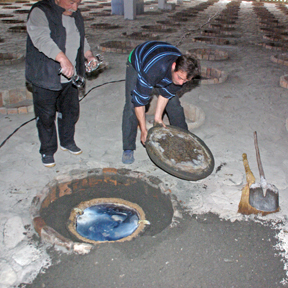 Two qvevris were opened so we could taste the wines. The first step in opening the qvevri is to remove the several-inches-deep sand covering the qvevri cover. The black sand is shoveled out of the area around the opening of the qvevri. A broom is used to sweep sand away from the qvevri top. The top was then removed from the opening. A ring of moist clay was around the opening of the qvevri. The clay creates a tight bond between the stone covering and the lip of the qvevri. Sand was placed over the opening and kept moist. This keeps the clay from drying out and allowing oxygen to enter the wine aging vessel.
Two qvevris were opened so we could taste the wines. The first step in opening the qvevri is to remove the several-inches-deep sand covering the qvevri cover. The black sand is shoveled out of the area around the opening of the qvevri. A broom is used to sweep sand away from the qvevri top. The top was then removed from the opening. A ring of moist clay was around the opening of the qvevri. The clay creates a tight bond between the stone covering and the lip of the qvevri. Sand was placed over the opening and kept moist. This keeps the clay from drying out and allowing oxygen to enter the wine aging vessel.
After the stone covering is removed, a film was observed resting over the wine at the top of the qvevri. Taking a wine class, the winery staff stirred the surfaces and the film moved to the side of the qvevri. Then wine was put into the wine glass. It is important to note that the wine had not been filtered. At the bottom of the qvevri the chacha (stems, seeds and skins) rested. The wine was crystal clear. Qvevris have a natural filtering ability based on their shape.
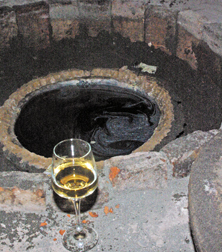 Our first wine from the qvevri was a 2013 Rkatsiteli. It was a dark gold color and had a floral aroma and taste. The wine had mild tannins and a crisp finish. There was a slightly floral aftertaste. The winery staff opened another qvevri, this one holding a 2013 Saperavi. The Saperavi was a dark purple to black color. Dark fruits were noted on the aroma. The taste offered black berries and plums. The wine had bold tannins and a fruity finish. In crafting the Saperavi, the winemaker kept the juice on its chacha for six days while the grapes were fermenting. The wine was then racked off the chacha and into another qvevri after six days to complete the fermentation and to age.
Our first wine from the qvevri was a 2013 Rkatsiteli. It was a dark gold color and had a floral aroma and taste. The wine had mild tannins and a crisp finish. There was a slightly floral aftertaste. The winery staff opened another qvevri, this one holding a 2013 Saperavi. The Saperavi was a dark purple to black color. Dark fruits were noted on the aroma. The taste offered black berries and plums. The wine had bold tannins and a fruity finish. In crafting the Saperavi, the winemaker kept the juice on its chacha for six days while the grapes were fermenting. The wine was then racked off the chacha and into another qvevri after six days to complete the fermentation and to age.
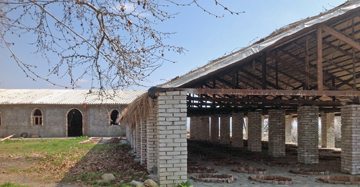 From the main marani we strolled to another marani that had a roof over it but was open on the sides. It appears that this marani is currently not used, evidenced by fallen leaves that gathered around the qvevri openings. Black Sea Wines plans to increase production in the future. When asked why the name Black Sea Wines for a winery in Kakheti, we were told that the owners liked the name.
From the main marani we strolled to another marani that had a roof over it but was open on the sides. It appears that this marani is currently not used, evidenced by fallen leaves that gathered around the qvevri openings. Black Sea Wines plans to increase production in the future. When asked why the name Black Sea Wines for a winery in Kakheti, we were told that the owners liked the name.
Black Sea Wines
Kardenakhi, Kakheti, Georgia
Article Written April 2014
